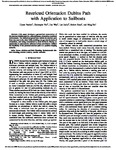Restricted Orientation Dubins Path with Application to Sailboats
| dc.contributor.author | Vautier, Ulysse | |
| dc.contributor.author | Viel, C | |
| dc.contributor.author | Jaulin, L | |
| dc.contributor.author | Wan, Jian | |
| dc.contributor.author | Hone, R | |
| dc.contributor.author | Dai, Yong Ming | |
| dc.date.accessioned | 2019-08-02T08:36:13Z | |
| dc.date.available | 2019-08-02T08:36:13Z | |
| dc.date.issued | 2019-07-23 | |
| dc.identifier.issn | 2377-3766 | |
| dc.identifier.issn | 2377-3774 | |
| dc.identifier.uri | http://hdl.handle.net/10026.1/14737 | |
| dc.description.abstract |
This letter develops a geometrical construction of the shortest Dubins path in a discontinuous orientation-restricted environment. The method proposed here builds the shortest path from one pose to the other while avoiding a no-go zone in terms of orientation, and being constrained to move forward. Finally, an application to autonomous sailboats is then provided to validate the feasibility of the planned shortest path in a position keeping scenario. | |
| dc.format.extent | 1-1 | |
| dc.language.iso | en | |
| dc.publisher | Institute of Electrical and Electronics Engineers (IEEE) | |
| dc.subject | Turning | |
| dc.subject | Path planning | |
| dc.subject | Face | |
| dc.subject | Indexes | |
| dc.subject | Planning | |
| dc.subject | Robots | |
| dc.subject | Motion and path planning | |
| dc.subject | nonholonomic motion planning | |
| dc.subject | motion control | |
| dc.subject | marine robotics | |
| dc.title | Restricted Orientation Dubins Path with Application to Sailboats | |
| dc.type | journal-article | |
| dc.type | Journal Article | |
| plymouth.author-url | https://www.webofscience.com/api/gateway?GWVersion=2&SrcApp=PARTNER_APP&SrcAuth=LinksAMR&KeyUT=WOS:000494827600015&DestLinkType=FullRecord&DestApp=ALL_WOS&UsrCustomerID=11bb513d99f797142bcfeffcc58ea008 | |
| plymouth.issue | 4 | |
| plymouth.volume | 4 | |
| plymouth.publication-status | Published | |
| plymouth.journal | IEEE Robotics and Automation Letters | |
| dc.identifier.doi | 10.1109/lra.2019.2930424 | |
| plymouth.organisational-group | /Plymouth | |
| plymouth.organisational-group | /Plymouth/Faculty of Science and Engineering | |
| plymouth.organisational-group | /Plymouth/Faculty of Science and Engineering/School of Engineering, Computing and Mathematics | |
| plymouth.organisational-group | /Plymouth/PRIMaRE Publications | |
| plymouth.organisational-group | /Plymouth/REF 2021 Researchers by UoA | |
| plymouth.organisational-group | /Plymouth/REF 2021 Researchers by UoA/UoA12 Engineering | |
| plymouth.organisational-group | /Plymouth/Research Groups | |
| plymouth.organisational-group | /Plymouth/Research Groups/Marine Institute | |
| plymouth.organisational-group | /Plymouth/Users by role | |
| plymouth.organisational-group | /Plymouth/Users by role/Academics | |
| plymouth.organisational-group | /Plymouth/Users by role/Researchers in ResearchFish submission | |
| dcterms.dateAccepted | 2019-07-10 | |
| dc.rights.embargodate | 2019-9-4 | |
| dc.identifier.eissn | 2377-3774 | |
| dc.rights.embargoperiod | Not known | |
| rioxxterms.funder | EPSRC | |
| rioxxterms.identifier.project | Hybrid Set-theoretic Approaches for Constrained Control and Estimation with Applications to Autonomous Sailing Boats | |
| rioxxterms.version | Accepted Manuscript | |
| rioxxterms.versionofrecord | 10.1109/lra.2019.2930424 | |
| rioxxterms.licenseref.uri | http://www.rioxx.net/licenses/all-rights-reserved | |
| rioxxterms.licenseref.startdate | 2019-07-23 | |
| rioxxterms.type | Journal Article/Review | |
| plymouth.funder | Hybrid Set-theoretic Approaches for Constrained Control and Estimation with Applications to Autonomous Sailing Boats::EPSRC |


